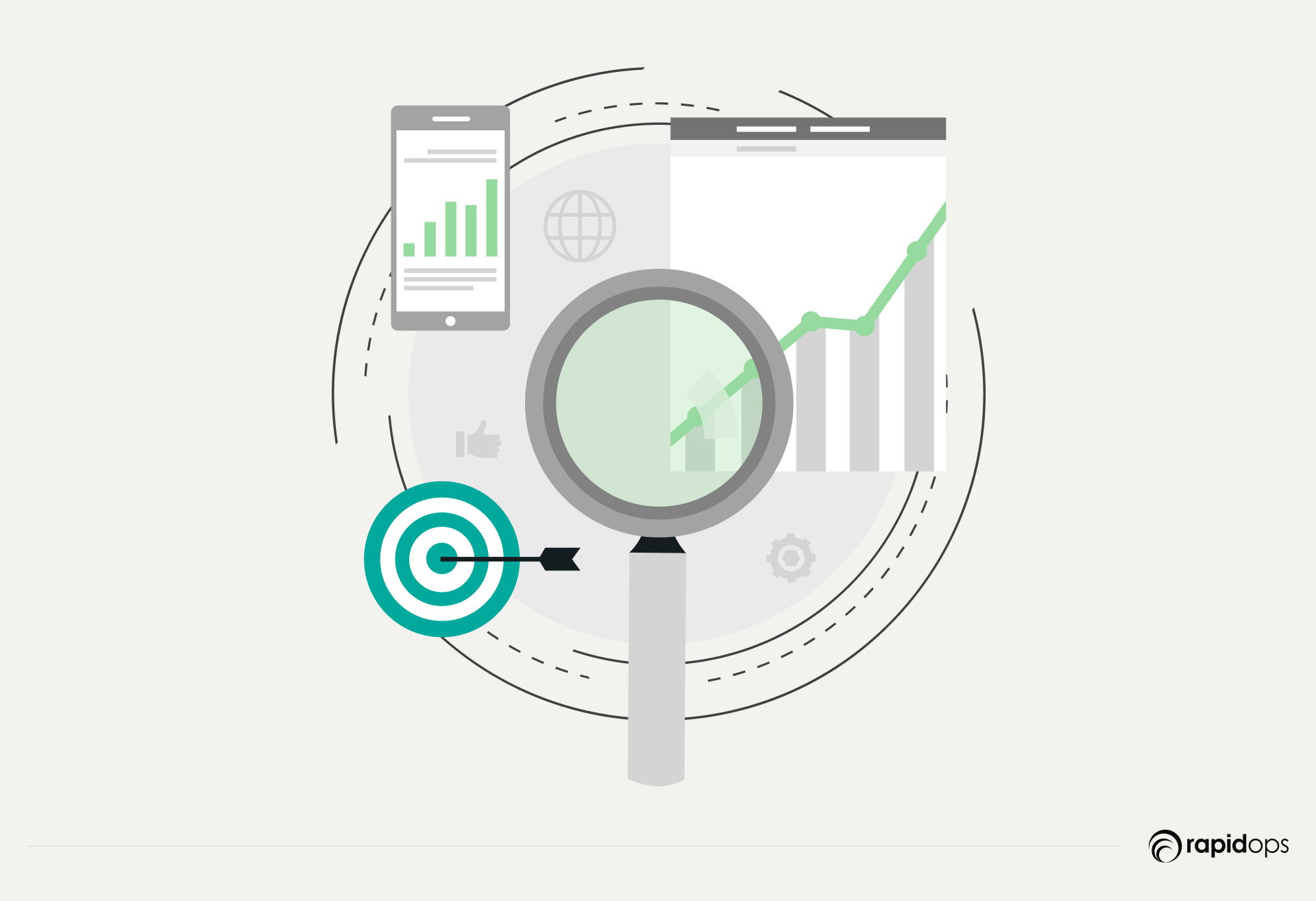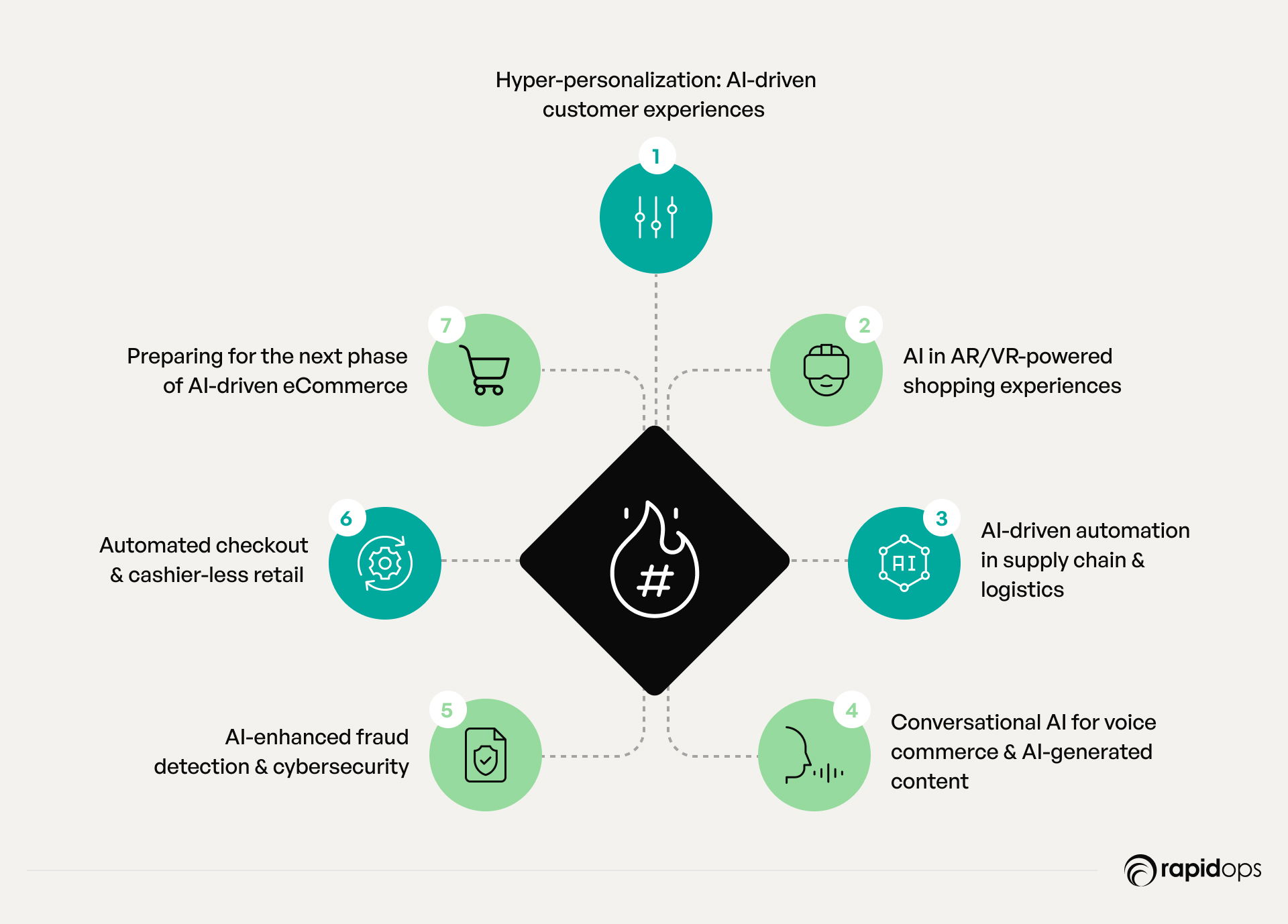- AI
- 32 min read
- March 2025
10 AI Tools to Boost Your Ecommerce Business in 2025
Key Takeaways
The global AI in retail market is projected to reach $31.18 billion by 2028, growing at a CAGR of 34.4% (Fortune Business Insights). AI is no longer a futuristic concept—it is a core business driver in eCommerce, transforming everything from customer experience to logistics and revenue optimization.
Businesses that fail to integrate AI into their eCommerce operations risk:
- Lower operational efficiency due to outdated, manual processes
- Missed revenue opportunities from non-personalized customer interactions
- Reduced profitability due to static pricing models and poor inventory forecasting
Key challenges AI is solving in eCommerce
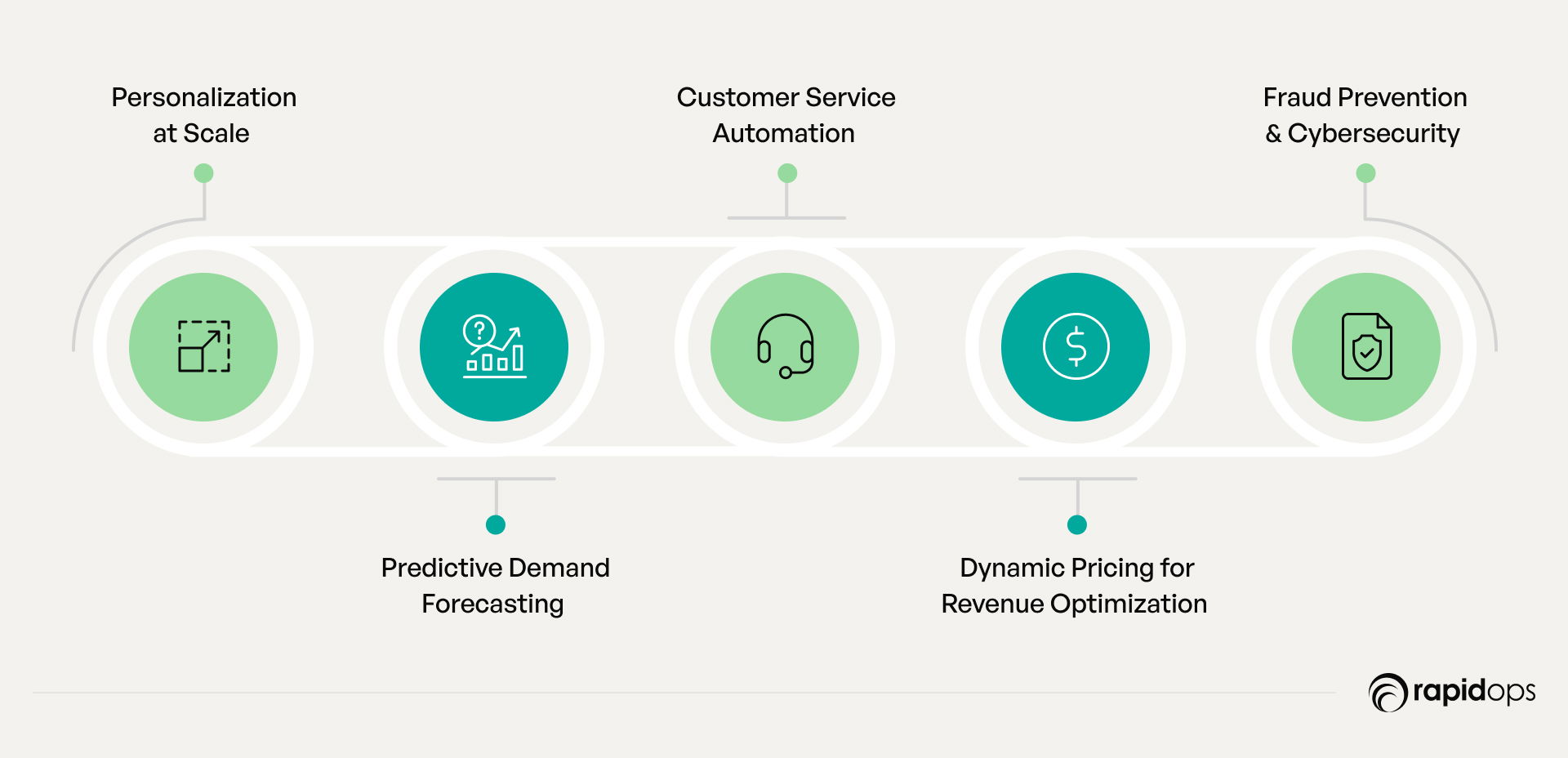
The success of eCommerce businesses hinges on solving the following operational challenges—areas where AI has become indispensable:
1. Personalization at Scale
- Traditional challenge: Generic product recommendations and static customer segmentation.
- AI solution: AI-powered recommendation engines boost conversion rates by 20-30% (McKinsey).
- Real-world impact: Amazon generates 35% of its total sales from AI-driven personalized recommendations.
2. Predictive demand forecasting
- Traditional challenge: Overstocking and understocking leading to revenue loss.
- AI solution: AI improves demand forecasting accuracy by 50%, optimizing inventory levels.
- Real-world impact: Walmart reduced inventory costs by 30% using AI-driven predictive analytics.
3. Customer service automation
- Traditional challenge: Long wait times, inefficient query resolution, and high operational costs.
- AI solution: AI chatbots and virtual assistants reduce support costs by 30%.
- Real-world impact: Sephora’s AI chatbot reduced customer service wait times by 70%.
4. Dynamic pricing for revenue optimization
- Traditional challenge: Static pricing models lead to missed revenue opportunities.
- AI solution: AI-driven dynamic pricing increases margins by 5-10%.
- Real-world impact: Uber Eats saw a 23% increase in revenue using AI-based pricing strategies.
5. Fraud prevention & cybersecurity
- Traditional challenge: eCommerce businesses lose billions to fraud and chargebacks.
- AI solution: AI reduces fraud-related chargebacks by 40%.
- Real-world impact: eBay’s AI fraud detection system reduced fake listings by 60%.
Why AI adoption is no longer optional for eCommerce leaders
AI’s ability to drive efficiency, boost sales, and enhance customer satisfaction is no longer just a competitive advantage—it is a business imperative. In 2025 and beyond, eCommerce businesses that fail to leverage AI will fall behind.
AI’s role in redefining eCommerce business operations
AI is not just an add-on to eCommerce operations—it is a fundamental driver of efficiency, profitability, and customer engagement.
From real-time decision-making to automation and predictive analytics, AI is transforming how businesses operate and compete in the digital marketplace.
AI’s impact on eCommerce is visible across four core business functions:
1. Customer experience and personalization

Consumers expect seamless, intuitive shopping experiences. AI enables hyper-personalization by analyzing user behavior, preferences, and purchase history to deliver tailored product recommendations, chatbot-driven interactions, and adaptive content.
Business impact:
- AI-driven recommendations contribute to 35% of Amazon’s total revenue.
- AI chatbots improve customer support efficiency by up to 30%, reducing human intervention and increasing resolution speed.
- Use case: Sephora’s AI-powered chatbot personalizes beauty product suggestions, reducing customer query resolution times by 70%.
2. Sales, marketing, and revenue optimization
AI is redefining digital marketing, customer acquisition, and pricing strategies by leveraging real-time data analytics to drive better conversions.
Business impact:
- AI-enabled predictive analytics improve marketing ROI by up to 20%.
- AI-driven dynamic pricing helps retailers optimize revenue, increasing profit margins by 5-10%.
- AI-powered email marketing automation increases customer engagement, with personalized content leading to a 41% improvement in open rates.
Use case: Adidas used AI-based marketing automation to enhance targeted campaigns, achieving a 15x return on investment.
3. Logistics, supply chain, and inventory management
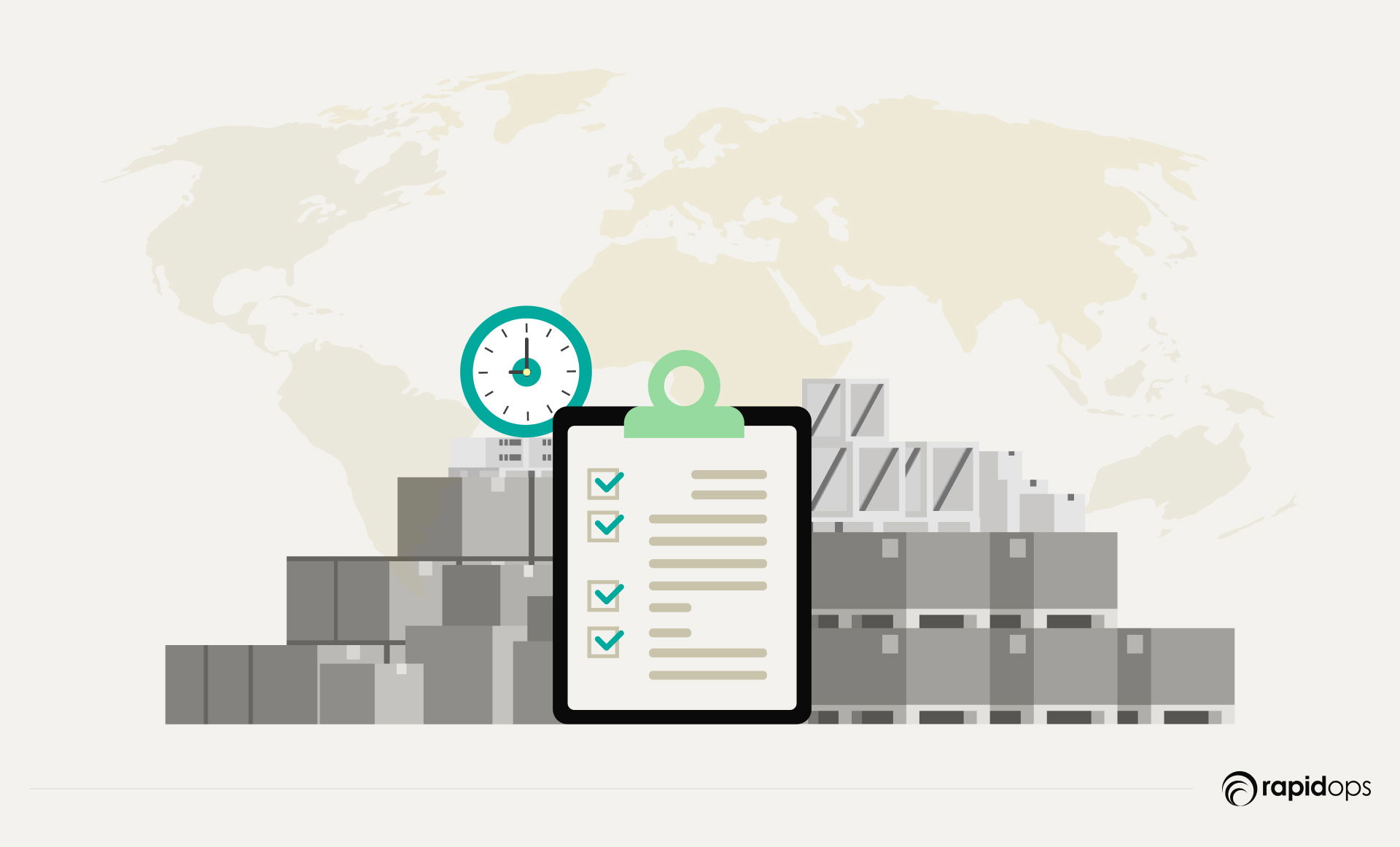
AI-powered logistics and inventory optimization help eCommerce businesses achieve faster deliveries, cost-effective warehousing, and accurate demand forecasting.
Business impact:
- AI-driven demand forecasting reduces stockouts and overstocking by 50%, cutting down operational costs.
- AI in warehouse automation increases order accuracy by 99.5%, reducing labor costs by 30%.
- AI-driven last-mile delivery solutions optimize routes and reduce delivery times by up to 25%.
Use case: Walmart’s AI-backed supply chain model reduced inventory costs by 30% while improving product availability.
4. Fraud detection, cybersecurity, and compliance

With the rise of digital transactions, fraud detection and data security have become critical concerns for eCommerce businesses. AI algorithms detect anomalies, prevent fraudulent activities, and ensure compliance with regulatory frameworks.
Business impact:
- AI reduces fraud-related chargebacks by 40%.
- AI-based authentication tools prevent account takeovers and reduce fraud attempts by 60%.
- AI-powered cybersecurity platforms detect suspicious transaction patterns and mitigate risks in real-time.
- Use case: eBay implemented AI-driven fraud detection systems, reducing scam listings by 60%.
AI’s role in scaling eCommerce businesses beyond 2025
Companies that integrate AI into their core operations are positioned to scale faster, enhance profitability, and remain competitive in a data-driven market. AI adoption is not just about efficiency—it is about unlocking new revenue streams and future-proofing business models.
The top 10+ AI tools for eCommerce success in 2025
Why AI tools are driving eCommerce growth
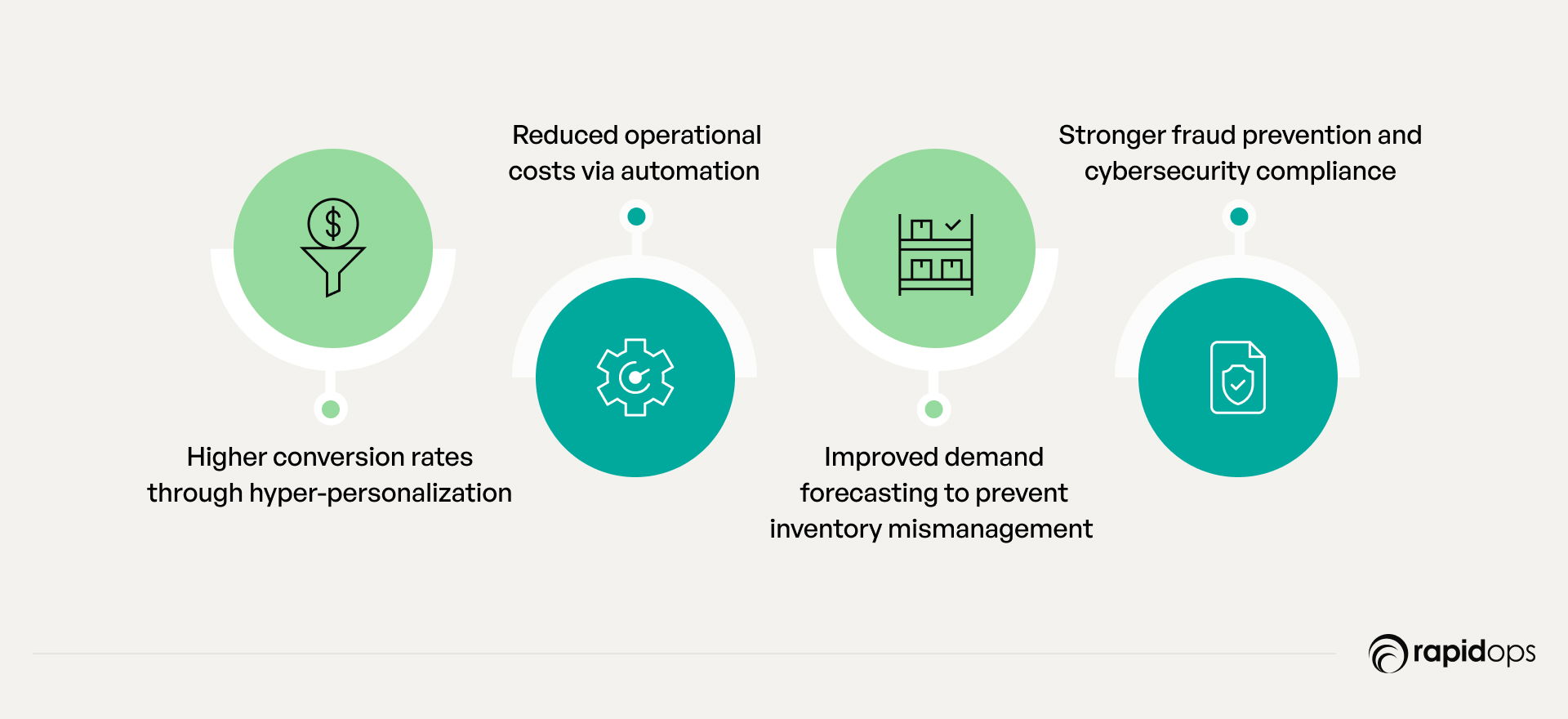
The rapid evolution of AI has introduced tools that help eCommerce businesses enhance customer experience, optimize marketing, streamline logistics, and prevent fraud. These tools are designed to drive tangible outcomes such as:
- Higher conversion rates through hyper-personalization
- Reduced operational costs via automation
- Improved demand forecasting to prevent inventory mismanagement
- Stronger fraud prevention and cybersecurity compliance
Below are 10 AI tools that every eCommerce business should consider integrating into their tech stack in 2025.
1. Experro: AI-powered search, personalization, and merchandising platform for eCommerce
Category: AI for product discovery, search relevance, and personalized customer experiences
Use cases: Intelligent site search, dynamic merchandising, 1:1 personalization, headless CMS integration
What Experro does
Experro is a composable, AI-native experience platform built specifically for modern eCommerce businesses.
It brings together:
- Search relevance optimization using NLP and behavioral signals
- Personalized merchandising across product listings and search pages
- Real-time behavioral targeting based on customer journeys
- Unified content, product, and customer data within a headless infrastructure
At its core, Experro enables eCommerce brands to deliver personalized shopping experiences at scale while maintaining granular control over every customer touchpoint.
How it works: the technical foundation
1. AI-powered search with NLP and vector-based ranking
Experro’s search engine is powered by:
- Natural Language Processing (NLP): Parses user intent and contextual meaning in long-tail queries, such as “summer dresses under AED 300 for tall women.”
- Real-time index updates: Ensures new products, price changes, and stock levels are reflected instantly.
- ML-based ranking models: Continuously learn from clickstream and zero-result data to improve ranking logic and suppress irrelevant results.
2. Real-time personalization engine
- Customer segmentation & profiling: Experro builds behavioral personas based on browsing, clickstream, and purchase data.
- 1:1 product ranking: Search and category results are dynamically reordered for each visitor.
- Zero-CRM personalization: Even anonymous users receive personalized experiences.
3. Headless CMS + AI-driven merchandising
Unified content and product data layers allow merchandisers to:
- Boost or bury products based on inventory, margin, or promotional strategies
- Define search rules visually using drag-and-drop editors
- Create dynamic landing pages personalized by campaign source, location, or segment
Who is using Experro
Experro powers a growing list of digitally mature D2C brands, category-specific retailers, and B2B distributors looking to modernize their product discovery stack without compromising performance or flexibility.
It is particularly favored by companies moving toward:
- Composable commerce architecture (e.g., using platforms like commercetools, BigCommerce, or Salesforce Commerce Cloud)
- Speed-focused headless storefronts powered by React, Vue, or Next.js
- Data-led merchandising operations seeking tighter control over conversion-critical surfaces
Business impact of Experro
|
Business Metric |
Impact with Experro |
|---|---|
|
Click-to-conversion rate |
↑ 35–40% |
|
Zero-result queries |
↓ by up to 90% |
|
Bounce rate on PLPs |
↓ 28% |
|
Merchandising efficiency |
↑ 2x improvement in execution speed |
|
Time to launch localized landing pages |
↓ from days to minutes |
Why Experro stands out
- Unlike legacy site search tools that focus on keyword matching, Experro is built AI-first, allowing for contextual understanding, proactive personalization, and operational flexibility.
- It supports real-time feedback loops, giving merchandisers and marketers visibility into what customers are searching, finding, and abandoning.
- It empowers business teams to act on insights without waiting on developers—making it highly scalable and adaptable for teams of all sizes.
Great. Let’s now cover the next tool category in-depth: AI-powered chatbots and virtual assistants, with a focused lens on ChatGPT (OpenAI), Zendesk AI, and Drift. These tools drive automation in customer support, reduce service costs, and accelerate conversions—making them vital for eCommerce businesses.
ChatGPT, Zendesk AI, Drift: AI-powered chatbots and virtual assistants
Category: Conversational AI for customer engagement and support automation
Use cases: Automated customer service, lead qualification, product Q&A, conversion optimization
What these tools do
AI chatbots and virtual assistants are designed to automate real-time conversations across channels like websites, apps, and messaging platforms. Their goal is to:
- Resolve support queries instantly without human agents
- Personalize product interactions and recommendations
- Qualify and route leads to the right sales reps
- Reduce cart abandonment by answering product, shipping, or return-related questions
Chatbots are no longer basic, rule-based responders. The new wave—powered by transformer models and NLU engines—can handle multi-turn conversations, learn from user interactions, and escalate intelligently.
How these tools work: Technical details
2. ChatGPT (OpenAI API)
Built on GPT-4 architecture, ChatGPT uses deep learning to understand natural language inputs and generate contextually appropriate responses.
- Developers can embed ChatGPT into their websites or eCommerce workflows via the OpenAI API, configuring response behavior, tone, and limitations.
- Functionality can be extended with product knowledge bases, order history integration, and external logic (e.g., delivery ETA check).
- For eCommerce, it acts as a customer concierge, able to assist with sizing questions, returns, restocking updates, and more.
Customizability: High — requires technical implementation but allows full control over tone, functionality, and integration.
3. Zendesk AI
Native to Zendesk’s customer service suite, Zendesk AI is built for automated ticket triage, intent detection, and reply suggestions.
Leverages machine learning models trained on customer service conversations across industries to predict customer needs.
Automates workflows such as:
- Classifying incoming tickets by urgency and topic
- Offering AI-generated replies for agents to approve or edit
- Deflecting queries to self-service content
- Includes Answer Bot, a no-code solution for automating up to 60% of repetitive queries.
Strength: Works out-of-the-box for companies using Zendesk, reducing manual ticket handling and first response times.
4. Drift
Drift focuses on revenue acceleration through AI-powered chat experiences.
Combines conversational marketing with AI chat to capture, qualify, and convert leads in real time.
Drift’s chatbot can:
- Identify high-intent visitors using IP and behavioral data
- Initiate contextual conversations
Dynamic Yield, Algolia Recommend, Amazon Personalize: AI for personalized product recommendations
Category: AI-powered recommendation engines
Use cases: Product cross-sell and upsell, dynamic homepage merchandising, individualized category ranking, email personalization
What these tools do
AI recommendation engines analyze user behavior, transaction history, and real-time engagement patterns to predict what products a user is most likely to buy next. They dynamically personalize:
- Product carousels on the homepage or PDPs
- Category listings tailored to user behavior
- Email product suggestions based on past or predicted preferences
- “Frequently bought together” and “You may also like” sections
These tools are foundational to increasing average order value (AOV), repeat purchase rates, and customer retention in eCommerce.
How these tools work: Technical breakdown
5. Dynamic Yield
Uses hybrid machine learning models, combining collaborative filtering (similar users/items) with content-based recommendations.
- Includes deep behavioral segmentation, allowing personalized experiences for both logged-in and anonymous users.
- Offers visual personalization rules, empowering marketers to define experiences without writing code.
- Integrates natively with CMS, POS, CRM, and ESP systems.
Notable features:
- Real-time experience optimization
- Server-side and client-side SDKs
- Built-in A/B testing and performance analytics
Used by: IKEA, Sephora, URBN (Urban Outfitters, Anthropologie)
6. Algolia Recommend
Built on Algolia’s fast indexing engine, this tool leverages vector-based similarity models to serve product recommendations instantly.
- Unlike traditional collaborative filtering, it incorporates semantic search signals, clickstream data, and trending item performance.
- Works out of the box with Algolia Search, enabling full-stack personalization.
Notable features:
- Cross-sell, upsell, and “frequently viewed with” widgets
- Fast performance optimized for mobile and international sites
- Front-end flexibility through customizable APIs
Used by: Gymshark, Lacoste, Staples
7. Amazon Personalize
A fully managed ML service from AWS, built on the same infrastructure as Amazon.com’s retail personalization engine.
Trains custom models on first-party customer data, including:
- Purchase and browsing history
- Product metadata
- Real-time interaction streams
- Offers recommendation APIs for product, reranking, and user segmentation use cases.
- Ideal for businesses with significant proprietary data and AWS integration.
Notable features:
- No machine learning experience required
- Built-in event ingestion, training pipelines, and performance monitoring
- Real-time inference with latency under 100ms
Used by: Domino’s, Subway, Zola, Yamaha
Business impact of AI-powered recommendation engines
|
KPI |
Average Impact |
|---|---|
|
Contribution to total revenue |
Up to 35% (Amazon) |
|
Repeat purchase rate |
↑ 26% (Forrester) |
|
Cart size and AOV |
↑ 20–25% |
|
Email click-through rates |
↑ 30–40% |
|
Time-on-site |
↑ 2x longer sessions |
Why these tools matter
- These tools shift product discovery from being static and catalog-driven to being fluid, predictive, and context-aware.
- They require minimal manual rule-setting—as the models train themselves and adapt over time.
- They integrate with frontend UX, marketing platforms, and CRMs to create omnichannel personalization loops.
Frontend UX Layer
- Website / App (React, Vue)
- Search bar & visual input
- Product detail & listing pages with visual recommendations
Visual Search Engine
- Syte or Google Vision AI
- Image parsing (CNNs)
- Visual similarity matching
- In-image object detection
- Auto-tagging & enrichment
Product Data Layer
- Product catalog (PIM)
- Tags, attributes, and imagery
- Real-time inventory sync
Personalization Engine
- Analyzes visual behavior data
- Dynamically adapts product layout & ordering
- Delivers visually similar product recommendations
Analytics & Feedback Loop
- Clickstream analysis & engagement metrics
- Split testing (A/B or multivariate)
- Tracking visual search performance
Pecan AI and Quantcast AI: AI for predictive analytics and demand forecasting
Category: Predictive analytics platforms for demand planning, customer behavior modeling, and marketing optimization
Use cases: Inventory forecasting, churn prediction, revenue projection, lead scoring, sales trend forecasting
What these tools do
Predictive analytics tools help eCommerce businesses forecast future outcomes based on historical and real-time data. Unlike static BI dashboards, these platforms use machine learning algorithms to model dynamic variables such as:
- Sales velocity and product demand
- Churn probability for customer cohorts
- Optimal timing for marketing outreach
- Revenue projections based on conversion pipelines
By modeling these factors, businesses can prevent stockouts, minimize dead stock, optimize ad spend, and improve retention.
How these tools work: technical breakdown
8. Pecan AI
Low-code predictive modeling platform designed for business analysts and data-savvy operators.
Uses automated feature engineering and advanced ML models (XGBoost, time series forecasting, classification trees) to build accurate predictions without requiring a data science team.
Integrates with SQL databases, data warehouses (Snowflake, BigQuery), CRMs, and ERPs to ingest raw transactional and behavioral data.
Popular use cases in eCommerce:
- Demand forecasting by SKU and region
- High-risk customer churn prediction
- Forecasting campaign ROI and conversion rates
- Inventory allocation based on projected demand
Used by: Johnson & Johnson, Mars Petcare, beverage distributors, DTC wellness brands
9. Quantcast AI (Q Platform)
Built for real-time audience analytics and media performance forecasting. Leverages its proprietary live internet dataset—anonymized behavioral signals from over 100 million web and app destinations.
Uses AI to dynamically identify in-market audiences, optimize campaign spend, and predict conversion likelihood.
Popular use cases in eCommerce:
- Predictive audience segmentation
- Budget allocation and bid strategy forecasting
- Personalized ad targeting and message optimization
Used by: LG, Toyota, American Eagle, agency-led retail campaigns
Business impact of predictive AI in eCommerce
|
KPI |
Impact Range |
|---|---|
|
Inventory holding cost reduction |
↓ 20–30% |
|
Forecasting accuracy |
↑ 40–50% over rule-based models |
|
Marketing ROI uplift |
↑ 25–40% |
|
Customer churn |
↓ by 15–20% with early identification |
|
Revenue loss due to stockouts |
↓ by 30% (especially in FMCG & seasonal retail) |
Why this matters for decision-makers
- Poor demand forecasting leads to locked-up working capital, markdowns, and fulfillment delays.
- Predictive AI reduces guesswork by connecting operational data with behavioral signals in near real-time.
- These tools shift organizations from reactive planning to proactive, data-driven decision-making.
Marketo Engage (Adobe) and Persado: AI for marketing automation and message optimization
Category: AI-driven marketing platforms for customer engagement, campaign performance, and message personalization
Use cases: Email marketing automation, customer journey orchestration, emotional language optimization, A/B testing, audience scoring
What these tools do
AI-powered marketing automation platforms streamline and personalize communications across email, SMS, social, and web. They leverage AI to:
- Predict optimal send times and channels
- Personalize subject lines and content blocks in real-time
- Optimize campaigns based on emotional and behavioral triggers
- Score leads and segment customers by purchase intent
These tools help marketing teams automate complexity at scale, driving higher ROI across acquisition, retention, and loyalty efforts.
How these tools work: technical breakdown
10. Marketo Engage (Adobe)
Uses AI-powered content personalization and adaptive segmentation to tailor campaigns across lifecycle stages.
- Offers predictive lead scoring based on historical conversion data, browsing activity, and engagement trends.
- Built-in AI surfaces the best-performing subject lines, call-to-actions, and offers through A/B and multivariate testing.
- Integrates deeply with Adobe Experience Cloud, CRMs (like Salesforce), and DMPs for omnichannel targeting.
Capabilities for eCommerce:
- Cart abandonment campaigns personalized by behavior
- Re-engagement journeys based on churn risk
- Dynamic product recommendations in emails
- Customer lifetime value (CLV) scoring for segmentation
Used by: Lenovo, GE Appliances, Panasonic, Honeywell
11. Persado
Specializes in generative AI for marketing language. Uses a massive knowledge base of emotional drivers, performance data, and language patterns to craft high-performing subject lines, headlines, CTAs, and messages.
Employs Natural Language Generation (NLG) to test different emotional tones (urgency, trust, curiosity, exclusivity) and their impact on engagement.
Analyzes customer segments to align language with the psychological motivators that drive action.
Capabilities for eCommerce:
- Optimizing product launch emails by emotion-led subject lines
- Personalizing banner copy for high-intent segments
- Scaling content testing beyond A/B into multi-emotional variants
- Improving CTA language in SMS and push notifications
Used by: Coach, Verizon, Gap, Ally Bank
Business impact of AI-driven marketing automation
|
KPI |
Average Impact |
|---|---|
|
Open rates |
↑ 41% (with AI-optimized send time + subject line) |
|
Click-through rates |
↑ 27% (with emotion-targeted language) |
|
Conversions from email |
↑ 20–30% on average |
|
Campaign production time |
↓ 60–70% (due to content automation) |
|
Revenue from re-engagement campaigns |
↑ 2–3x vs traditional batch emails |
Why this matters for decision-makers
- In high-competition eCommerce, timing, tone, and personalization can be the difference between bounce and conversion.
- These tools reduce marketing reliance on gut-feel copywriting and enable teams to test and scale content with scientific precision.
- For mid-market to enterprise brands, they ensure faster time-to-campaign and higher ROI per dollar spent.
Prisync and Feedvisor: AI for dynamic pricing and revenue optimization
Category: AI-powered pricing intelligence and automation platforms
Use cases: Competitive price monitoring, automated repricing, revenue optimization, Buy Box strategy (Amazon), margin control
What these tools do
Dynamic pricing tools allow eCommerce businesses to automatically adjust product prices based on factors like competitor pricing, demand shifts, inventory levels, historical conversion rates, and profitability targets.
By continuously tracking the market and applying intelligent repricing rules, these tools help businesses:
- Maintain competitive pricing without sacrificing margins
- Win Buy Box placements on marketplaces like Amazon
- Increase conversion rates by adapting pricing to demand and customer intent
- Prevent over- or underpricing during promotions or stock fluctuations
How these tools work: Technical breakdown
12. Prisync
A plug-and-play SaaS tool that tracks competitor prices across online stores and marketplaces in real time.
Uses AI to recommend or automatically apply optimal prices based on:
- Price gaps with competitors
- Profit margin targets
- Stock availability
- Supports rule-based or AI-suggested dynamic pricing per product or category.
- Includes price history tracking, channel-specific pricing strategies, and automated reporting dashboards.
Integration:
- Compatible with Shopify, WooCommerce, Magento, BigCommerce, and custom platforms via API
- Enables batch uploads, channel-based adjustments, and alerting
Used by: Samsung, Puma, Intersport, Carrefour
13. Feedvisor
Built specifically for large-scale sellers and brands on Amazon, Feedvisor uses AI algorithms to:
- Optimize pricing for Buy Box wins
- Manage promotions across product groups
- Forecast profitability and net margin
- Incorporates elasticity modeling, which estimates how sensitive demand is to price changes
- Dynamically balances ad spend, pricing, and inventory to maximize total revenue from each SKU
Key capabilities for Amazon sellers:
- Real-time Buy Box repricing
- AI-powered ad campaign automation (via Feedvisor360)
- Inventory-aware pricing strategy based on predicted sell-through
Used by: Fortune 500 brands, top 1% Amazon sellers, global electronics and home goods distributors
Business impact of dynamic pricing AI
|
KPI |
Measurable Impact |
|---|---|
|
Buy Box win rate (Amazon) |
↑ 20–35% with real-time AI repricing |
|
Gross margin |
↑ 5–10% through strategic dynamic adjustments |
|
Sales velocity |
↑ 15–25% in competitive categories |
|
Revenue leakage due to mispricing |
↓ by 80% |
|
Manual repricing time |
↓ by up to 90% |
Why this matters for decision-makers
- Manual pricing based on static spreadsheets is no longer sustainable—especially in fast-moving or high-SKU eCommerce operations.
- AI-driven pricing tools protect profit margins while staying competitive across marketplaces and regions.
- These platforms turn pricing into a growth and conversion lever, rather than just a cost-based constraint.
Locus Robotics and GreyOrange: AI for warehouse automation and fulfillment
Category: AI-driven robotics and automation platforms for eCommerce fulfillment centers
Use cases: Automated picking, dynamic order batching, smart zone routing, real-time warehouse orchestration
What these tools do
AI-driven warehouse automation platforms use autonomous mobile robots (AMRs) and AI-based orchestration engines to optimize the picking, packing, and fulfillment process inside warehouses and distribution centers.
These tools enable businesses to:
- Reduce dependence on manual labor and minimize human error
- Scale fulfillment operations efficiently during peak demand (e.g., BFCM, seasonal surges)
- Increase picking accuracy, route optimization, and real-time resource allocation
- Improve throughput without expanding physical warehouse space
How these tools work: technical breakdown
14. Locus Robotics
Deploys fleets of LocusBots, which are collaborative AMRs designed to work alongside human pickers.
AI algorithms assign optimal picking tasks to robots based on:
- Item location
- Worker proximity
- Order priority and SLAs
- Supports multi-order batching, where a robot collects items for multiple orders in a single run.
- Provides real-time visibility dashboards for warehouse managers to monitor KPIs like units per hour, robot efficiency, and order backlogs.
Integration:
- Compatible with major WMS platforms (Manhattan, Blue Yonder, Oracle)
- Real-time data sync through APIs and middleware
Used by: DHL Supply Chain, Boots UK, GEODIS, Ryder, Material Bank
15. GreyOrange (Ranger and GreyMatter)
Offers a full suite of fulfillment automation through its Ranger AMRs and GreyMatter orchestration platform.
GreyMatter uses AI to:
- Prioritize orders by fulfillment urgency
- Assign robots based on predictive load-balancing
- Dynamically optimize pick-paths based on real-time congestion
- Capable of multi-zone inventory orchestration, supporting high-volume eCommerce and omnichannel fulfillment strategies.
Standout capabilities:
- System self-healing—reroutes in real-time if a robot is delayed or congested
- Inventory-aware order batching—matches orders to where inventory is stored for fewer movements
- Integrates with robotics from other providers and legacy systems
Used by: H&M, Walmart, Flipkart, logistics arms of large retail conglomerates
Business impact of warehouse automation AI
|
KPI |
Average Impact |
|---|---|
|
Picking productivity (units/hour) |
↑ 2–3x over manual-only processes |
|
Order accuracy |
↑ to 99.5% |
|
Labor cost savings |
↓ 30–50% |
|
SLA adherence (on-time shipping) |
↑ 25–40% |
|
Warehouse space utilization |
↑ through dynamic layout optimization |
Why this matters for decision-makers
- The cost and volatility of labor—especially in high-growth or cross-border eCommerce—make scalable automation a long-term strategic necessity.
- AI-powered orchestration and robotics not only reduce fulfillment bottlenecks but also improve customer satisfaction through faster and error-free deliveries.
- These tools provide operational resilience, enabling warehouses to absorb demand spikes without hiring surges or expansion.
How to implement AI in your eCommerce business
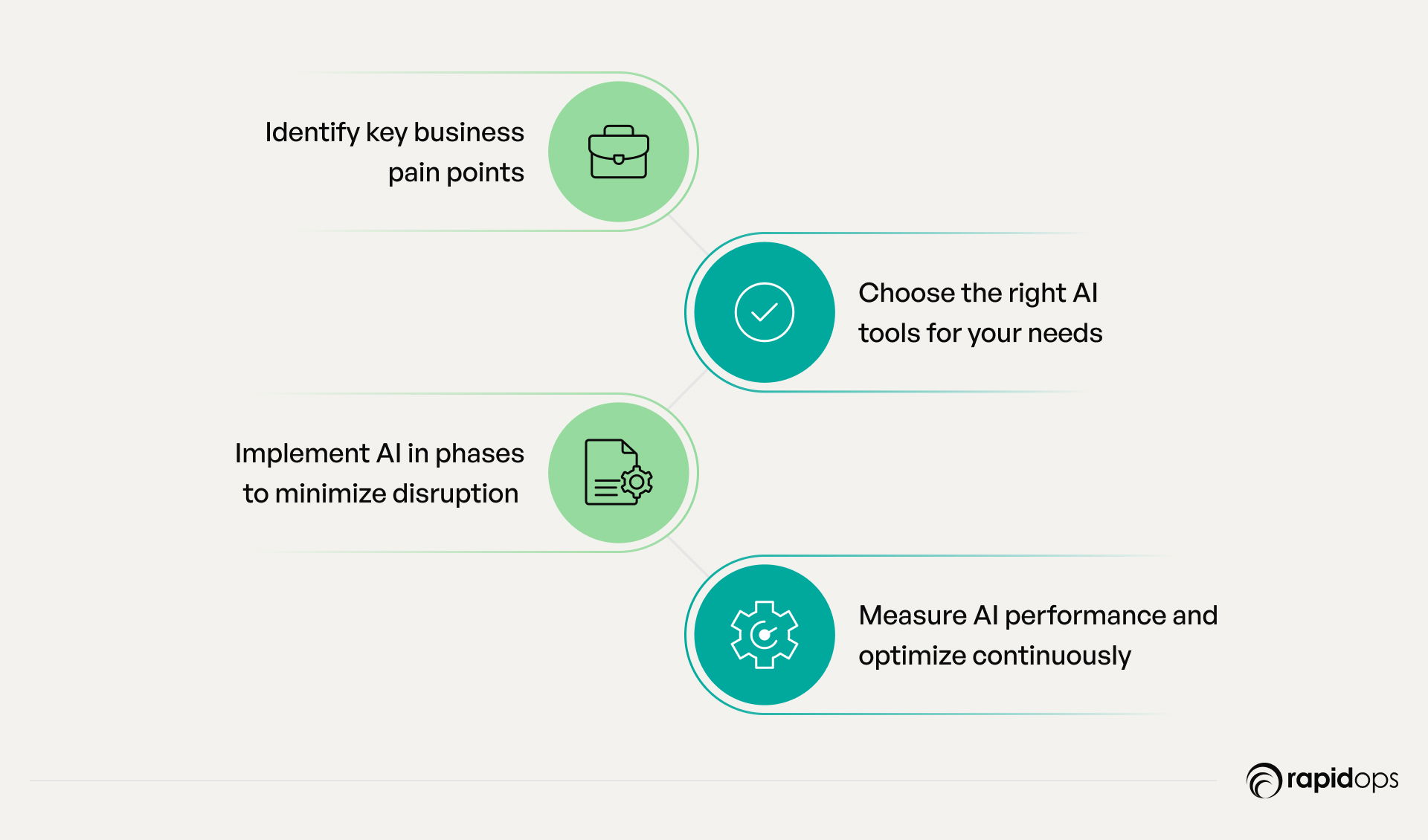
AI adoption in eCommerce is not about using technology for the sake of innovation—it is about integrating AI in a way that delivers measurable business outcomes. Whether it is improving customer experience, optimizing inventory, or reducing fraud, successful AI implementation requires a structured approach.
This section outlines a step-by-step framework for selecting, integrating, and scaling AI tools in eCommerce operations.
Step 1: Identify key business pain points
AI adoption must be aligned with specific business needs. A successful AI strategy starts with assessing:
- Customer experience challenges: Are customers facing delays, irrelevant recommendations, or inconsistent support?
- Sales and marketing inefficiencies: Is customer acquisition expensive? Are email campaigns underperforming?
- Inventory and supply chain issues: Are stockouts or excess inventory affecting profitability?
- Security risks: Are fraud and chargebacks impacting revenue?
Action point: Conduct an internal audit to determine which areas of your business will benefit the most from AI-driven automation and decision-making.
Step 2: Choose the right AI tools for your needs
Once business pain points are identified, selecting the right AI solution is critical. Decision-makers should evaluate AI tools based on:
- Functionality: Does the AI tool specifically address the identified business problem?
- Integration capabilities: Can it seamlessly connect with existing platforms like ERP, CRM, or inventory management systems?
- Scalability: Can the AI tool scale as the business grows?
- Data security compliance: Does it meet industry standards for data privacy and security?
Example framework for AI tool selection:
|
AI Use Case |
AI Tool |
Key Benefit |
Integration Capability |
|
Customer Support Automation |
Zendesk AI, Drift |
Reduces response time by 70% |
Connects with CRM and helpdesk platforms |
|
Dynamic Pricing |
Prisync, Feedvisor |
Optimizes pricing for revenue growth |
Syncs with eCommerce platforms |
|
Fraud Prevention |
Signifyd, Riskified |
Reduces fraudulent chargebacks by 40% |
Works with payment gateways |
Action point: Shortlist AI tools based on your business’s priority use cases and assess them for compatibility with existing infrastructure.
Step 3: Implement AI in phases to minimize disruption
Many eCommerce businesses fail in AI implementation because they attempt a complete overhaul without testing AI performance in real-world scenarios. A phased rollout allows businesses to monitor AI effectiveness before full deployment.
Best practices for AI implementation:
- Pilot testing: Implement AI tools in a single business function (e.g., chatbot for customer support) before scaling across multiple areas.
- Data quality assurance: AI relies on clean, structured data. Businesses must ensure high-quality data inputs for accurate AI predictions.
- Human-AI collaboration: AI should complement human decision-making, not replace it. Employees should be trained to work alongside AI.
Case study: Walmart introduced AI-driven predictive analytics in select warehouses before expanding the system across its entire supply chain, reducing operational costs by 30% and improving availability.
Action point: Deploy AI in one department first, track results, and gradually scale based on performance data.
Step 4: Measure AI performance and optimize continuously
AI models are not static solutions—they require continuous optimization based on real-time data. Key performance indicators (KPIs) should be defined from the outset to measure AI effectiveness.
KPIs for AI success in eCommerce:
- Conversion rate improvement: Have AI-driven personalization and recommendations increased sales?
- Customer support efficiency: Has AI automation reduced response times and improved resolution rates?
- Operational cost savings: Has AI-driven inventory optimization reduced waste and stockouts?
- Fraud prevention metrics: Have AI algorithms decreased chargebacks and unauthorized transactions?
Case study: Adidas optimized its AI-powered marketing campaigns by analyzing performance data, leading to a 15x increase in return on digital marketing investment.
Action point: Implement a data-driven feedback loop to adjust AI strategies based on ongoing insights.
Scaling AI for long-term success
Once AI has proven successful in a specific function, businesses should expand adoption across multiple departments.
- Enhancing AI capabilities: Explore advanced AI applications like predictive customer behavior modeling and AI-driven logistics automation.
- Combining AI with other technologies: AI works best when integrated with big data analytics, blockchain for secure transactions, and IoT for real-time inventory tracking.
Case study: Amazon has continuously expanded its AI adoption from recommendation engines to AI-powered logistics and warehouse robotics, setting the benchmark for scalable AI-driven eCommerce operations.
AI trends that will dominate eCommerce beyond 2025
AI is continuously evolving, driving new opportunities for efficiency, personalization, and automation in eCommerce. Businesses that stay ahead of these innovations will not only enhance their competitive edge but also future-proof their operations.
This section explores the most impactful AI trends shaping the future of eCommerce.
1. Hyper-personalization: AI-driven customer experiences
Consumers expect personalized interactions across all touchpoints, and AI is refining this process through real-time behavioral tracking, sentiment analysis, and predictive analytics.
Key innovations in hyper-personalization:
- AI-generated product recommendations based on customer intent rather than just past behavior.
- Dynamic website content adaptation to personalize landing pages in real time.
- AI-driven conversational commerce using chatbots that anticipate customer needs before they ask.
- Industry impact: AI-powered personalization is projected to drive 20% revenue growth for eCommerce businesses by 2027 (Gartner).
Case study: Amazon’s AI recommendation engine contributed to a 35% increase in sales, using predictive data models to tailor customer suggestions.
2. AI in AR/VR-powered shopping experiences
AI is reshaping eCommerce by integrating augmented reality (AR) and virtual reality (VR) into the shopping experience. These innovations enhance customer engagement and reduce return rates.
Applications of AI in AR/VR shopping:
- AI-powered virtual try-ons for fashion and cosmetics.
- Augmented reality product previews that allow customers to visualize items in real-world settings.
- AI-guided virtual shopping assistants that simulate an in-store experience online.
- Industry impact: The AI-powered AR/VR shopping market is expected to exceed $78 billion by 2030 (Statista).
Case study: IKEA implemented an AI-driven AR shopping feature, reducing return rates by 20% as customers could better visualize products before purchase.
3. AI-driven automation in supply chain and logistics
AI will continue to transform eCommerce logistics by enhancing predictive demand forecasting, smart warehousing, and autonomous last-mile delivery.
Key innovations:
- AI-powered robotic fulfillment centers that optimize inventory picking and reduce manual errors.
- Real-time AI supply chain monitoring for proactive demand adjustments.
- Autonomous delivery solutions integrating AI-driven drones and self-driving vehicles.
- Industry impact: AI is expected to increase global supply chain efficiency by 30% by 2030 (McKinsey).
Case study: Walmart’s AI-driven logistics system has cut supply chain costs by 30%, improving overall operational efficiency.
4. Conversational AI for voice commerce and AI-generated content
Voice commerce is becoming an integral part of online shopping, with AI-driven assistants enabling seamless hands-free transactions and automated product recommendations.
Key innovations:
- AI-powered voice assistants that handle product inquiries and purchase decisions.
- AI-generated content for personalized product descriptions and email campaigns.
- AI-based predictive search that enhances natural language processing for eCommerce platforms.
- Industry impact: Voice commerce is expected to surpass $40 billion in global sales by 2026 (OC&C Strategy Consultants).
Case study: Walmart integrated AI-driven voice commerce via Google Assistant, increasing repeat purchases by 14%.
5. AI-enhanced fraud detection and cybersecurity
As eCommerce grows, so do cyber threats. AI is being used to detect fraudulent transactions, enhance payment security, and prevent data breaches.
Key innovations:
- AI-powered anomaly detection for suspicious transaction patterns.
- Real-time fraud prevention systems that use machine learning to block unauthorized activity.
- AI-driven biometric authentication for secure customer verification.
- Industry impact: AI-driven fraud detection solutions have reduced fraudulent transactions by 60% for major eCommerce platforms (Experian).
Case study: eBay’s AI-based fraud detection system decreased scam listings by 60%, enhancing buyer protection.
6. Automated checkout and cashier-less retail
AI is streamlining in-store and online payments through contactless, automated checkout systems.
Key innovations:
- AI-powered facial recognition payments for seamless transactions.
- Cashier-less retail experiences integrating AI-driven sensors and analytics.
- AI-enhanced transaction security for preventing payment fraud.
- Industry impact: The global market for AI-powered checkout solutions is projected to exceed $80 billion by 2028 (CB Insights).
Case study: Amazon Go’s AI-driven checkout technology has reduced checkout time by 75%, creating a frictionless shopping experience.
7. Preparing for the next phase of AI-driven eCommerce
Businesses that embrace these AI trends will be better positioned to scale, optimize costs, and enhance customer satisfaction.
AI will become more predictive, reducing inefficiencies across the eCommerce ecosystem.
AI-led automation will improve customer engagement, personalization, and supply chain management.
Final thoughts: AI as the defining factor for eCommerce success
AI is not a passing trend in eCommerce—it is the foundation for sustainable growth, operational efficiency, and customer engagement. Businesses that fail to integrate AI into their core operations will struggle to compete in a market where automation, data intelligence, and real-time decision-making define success.
The cost of not adopting AI in eCommerce

Companies that do not leverage AI will face:
- Higher operational costs due to manual inefficiencies.
- Lower conversion rates as competitors implement AI-driven personalization.
- Increased risk of fraud and security breaches without AI-powered anomaly detection.
- Ineffective marketing strategies that fail to target the right customers at the right time.
- Logistics bottlenecks and supply chain inefficiencies resulting in delayed fulfillment.
- Businesses that delay AI adoption will not just miss opportunities—they will fall behind in an industry that is evolving faster than ever.
AI is the key to scalability, profitability, and competitive advantage
AI-driven automation allows businesses to reduce costs while increasing efficiency. The ability to predict demand, personalize customer experiences, and optimize pricing gives eCommerce companies a measurable advantage.
Key takeaways for AI-driven eCommerce growth:
✔ AI-powered personalization increases revenue by 20-30% (McKinsey).
✔ AI-enhanced fraud detection prevents 60% of fraudulent transactions (Experian).
✔ AI-driven supply chain optimization reduces operational costs by 30% (DHL Research).
✔ AI-enabled marketing automation improves ROI by up to 15x (Salesforce).
What eCommerce leaders should do next
To stay competitive, eCommerce decision-makers must:
- Audit existing business operations and identify areas where AI can deliver maximum impact.
- Select AI tools based on business needs, scalability, and integration with current systems.
- Start with a phased AI implementation to minimize disruptions and measure ROI.
- Monitor AI performance metrics and optimize continuously to enhance efficiency.
- Scale AI adoption across all business functions, from marketing to logistics and fraud prevention.
- Partner with AI and data experts to transform your eCommerce business
The future of eCommerce is driven by AI-powered automation, predictive analytics, and hyper-personalization. Businesses that leverage AI effectively will outperform competitors, optimize operations, and unlock new revenue streams.
At Rapidops, our team of AI and data engineers specializes in building custom AI solutions tailored for eCommerce operations. Whether you are looking to enhance customer engagement, improve demand forecasting, streamline logistics, or strengthen fraud detection, we bring deep technical expertise and a proven track record of driving digital transformation.
Let’s build the future of your eCommerce business together. Get in touch with our experts to discuss how AI can revolutionize your operations and fuel long-term growth.
What’s Inside
- Key challenges AI is solving in eCommerce
- Why AI adoption is no longer optional for eCommerce leaders
- AI’s role in redefining eCommerce business operations
- AI’s role in scaling eCommerce businesses beyond 2025
- The top 10+ AI tools for eCommerce success in 2025
- How to implement AI in your eCommerce business
- Scaling AI for long-term success
- AI trends that will dominate eCommerce beyond 2025
- Final thoughts: AI as the defining factor for eCommerce success

